Background
Rotosound was (and still is) a British manufacturer of musical instrument strings. The company was founded by James How during the 1950s, and it eventually became well known for its guitar & bass strings.
By the 1960s, Rotosound had also established a retail outlet on Denmark Street, which was where they sold their own products, as well as musical instruments & accessories branded for them.1 During the period spanning from approximately the mid-1960s, through to the early 1970s, Rotosound also offered various different fuzz boxes.
Different versions
Rotosound Fuzz Box (cast metal housings), 1966-1968
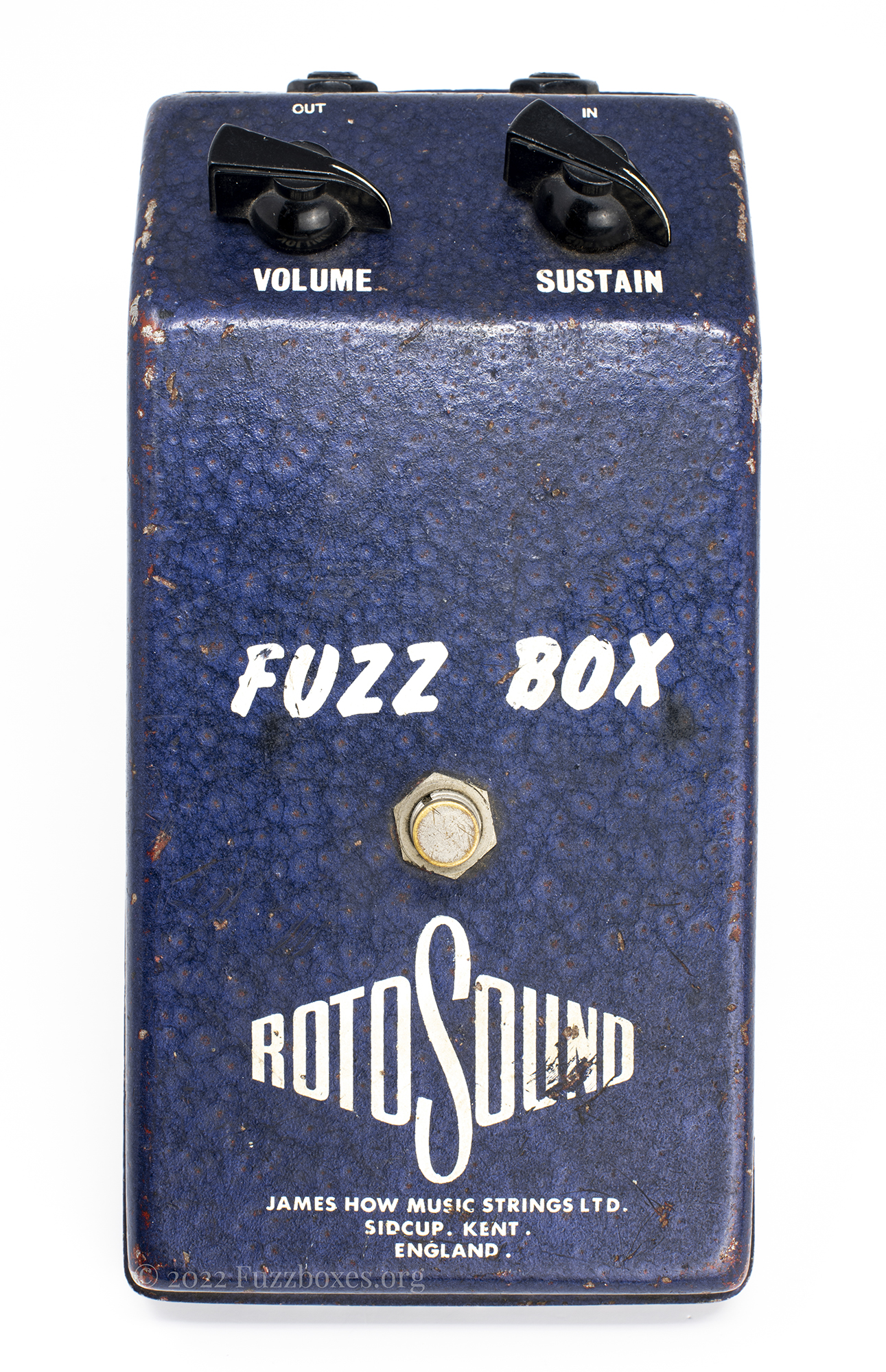
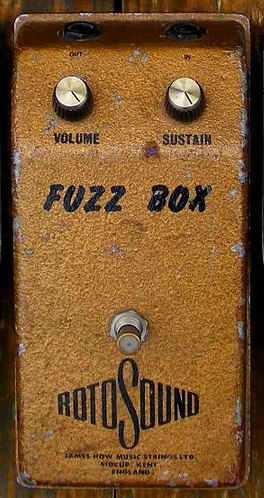
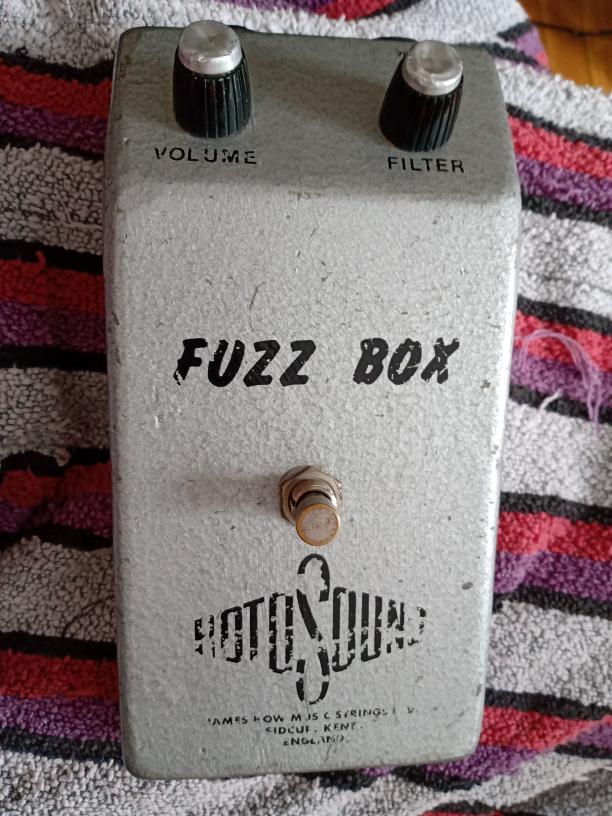
Between 1966 and 1968, the Rotosound Fuzz Box was built into large cast aluminium enclosures. As pictured above, these pedals came equipped with two control knobs, and they were decorated with simple silk screened graphics. The Fuzz Boxes in the cast enclosures were actually supplied to Rotosound by Sola Sound, who were responsible for the circuit assembly. Because the shape & design are visually quite similar to the various other pedals being manufactured by Sola Sound in 1966 (e.g. the Tone Bender & Fuzzbug), we can assume that these housings were also designed & cast by the same people. Despite the fact that the pedals above all look more or less the same, they have actually all been built with noticeably different electronic circuits. (Photo credit: D. Main & J. Charles)
The earliest known Rotosound Fuzz Boxes in the cast metal enclosure were painted in a dark blue hammertone finish, and they date to 1966. These pedals feature Sola Sound’s two-transistor ‘MK1.5’ fuzz circuit, which was the same circuit that was more famously also used for Sola Sound’s unbranded ‘Tone Bender’ pedals. One surviving example of the blue Rotosound Fuzz Box has a faint stamp on the inside of its bottom plate, listing the Charing Cross Road address for Macari’s Musical Exchange, which suggests that this Rotosound-branded product may very well have been originally sold at Sola Sound’s own retail outlet.
Gold-painted Fuzz Box pedals appear to have followed the blue Rotosound pedals. These pedals can be dated approximately to late 1966, by the fact that gold Fuzz Boxes have been sighted with both late-production examples of the two-transistor ‘MK1.5’ fuzz circuit, as well as with a relatively early version of the Tone Bender Professional MKII circuit (which was Sola Sound’s succession to the earlier ‘MK1.5’ design). All of the known 1966-era Rotosound pedals (both gold & blue varieties) featured Mullard OC75 transistors.
Another version of Sola Sound’s Fuzz Box was being branded & supplied to Rotosound in 1968 (as ascertained by examining date codes on pedals, and by a wider understanding of the development of the Tone Bender MKII circuit). All of the silver Fuzz Boxes known to have survived thus far have been built with a particularly late version of the Tone Bender MKII circuit, and with a noticeably different selection of components to the earlier models, this time featuring Mullard OC81D transistors.
The reason why the Rotosound Fuzz Box has been sighted with a variety of significantly different circuits, despite having been built by the same company, is linked with our understanding of Sola Sound’s business model during the 1960s & 1970s. The pedals that Sola Sound manufactured for Rotosound came with the same circuits as those that the company was also supplying to other companies like Vox, Marshall & Dallas. Pictured above, are the near-identical internals of a 1966 unbranded Tone Bender ‘MK1.5’, and a 1966 Rotosound Fuzz Box.
The fact that the circuitry in these blue, gold & silver Fuzz Boxes varies is a result of the natural evolution of Sola Sound’s two & three-transistor fuzz circuits over the course of the almost 2-year period of production. The gradual change in circuitry & parts selection may have come about as a result of restocking parts supplies at the factory, or simply by design choices, but the same phenomenon can be observed in the development of the fuzz pedals that Sola Sound was supplying other companies with concurrently. A helpful way of looking at this is by considering that the type of Tone Bender fuzz circuit (e.g. ‘MKI’, ‘MK1.5’ or MKII) that Sola Sound built into enclosures of each model (i.e. SupaFuzz, Fuzz Box, Fuzzbug, or even ‘Tone Bender’) don’t necessarily correlate in any meaningful way other than that those circuits are what Sola Sound happened to have been building at the time.
Unbranded ‘Fuzz Box’ pedals, c. 1966

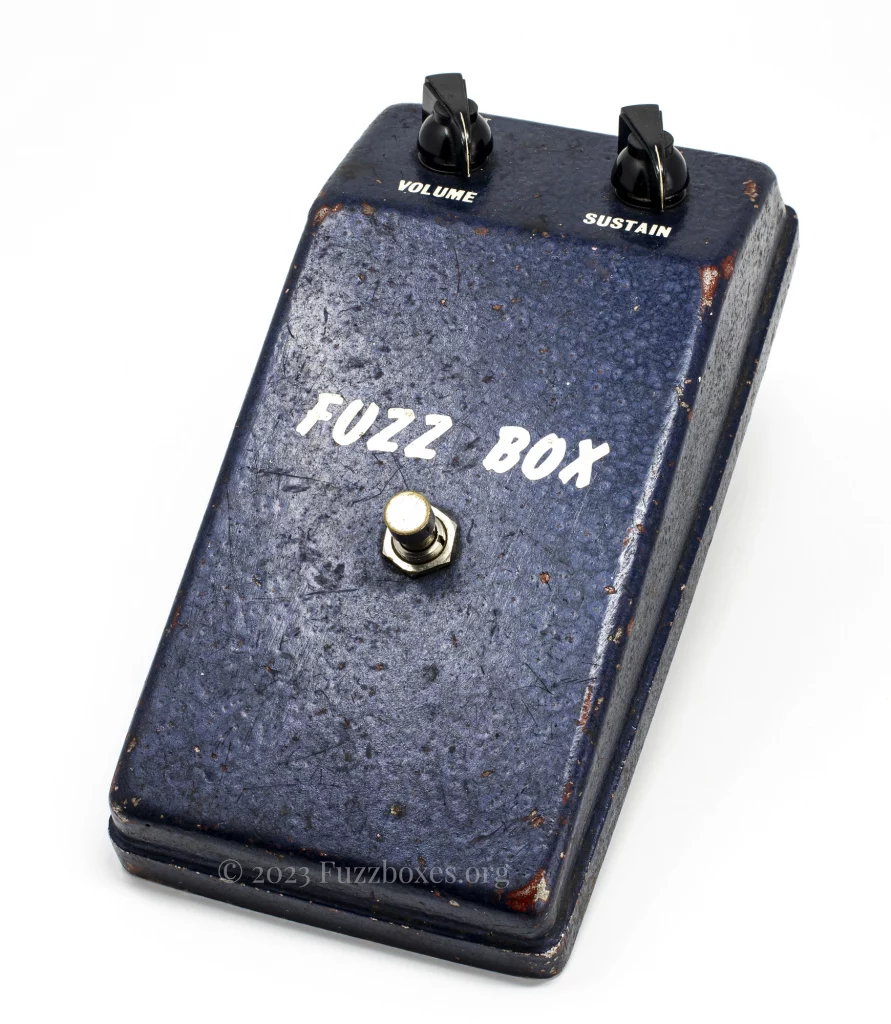
Joe Macari was photographed apparently showing a pair of unbranded ‘Fuzz Box’ pedals to an unknown group. These pedals were presumably painted in blue, and likely featured the two-transistor ‘MK1.5’ circuit, but this is unconfirmed. (Photo credit: Macari’s Musical Exchange/Sola Sound)
At the time of writing, only one example of an unbranded blue Fuzz Box is known to have survived. Other than the lack of any company’s branding printed to the pedal, this particular ‘Fuzz Box’ is identical to the blue Rotosound-branded pedal pictured earlier. The reason why the Rotosound name hasn’t been printed onto the enclosure is likely that Sola Sound was also supplying the same model to other businesses. Anecdotal evidence behind this particular example reveals that it was originally sold at a music shop in Ireland.
Rotosound Fuzz Box (pressed steel housings), 1968- c. 1970s
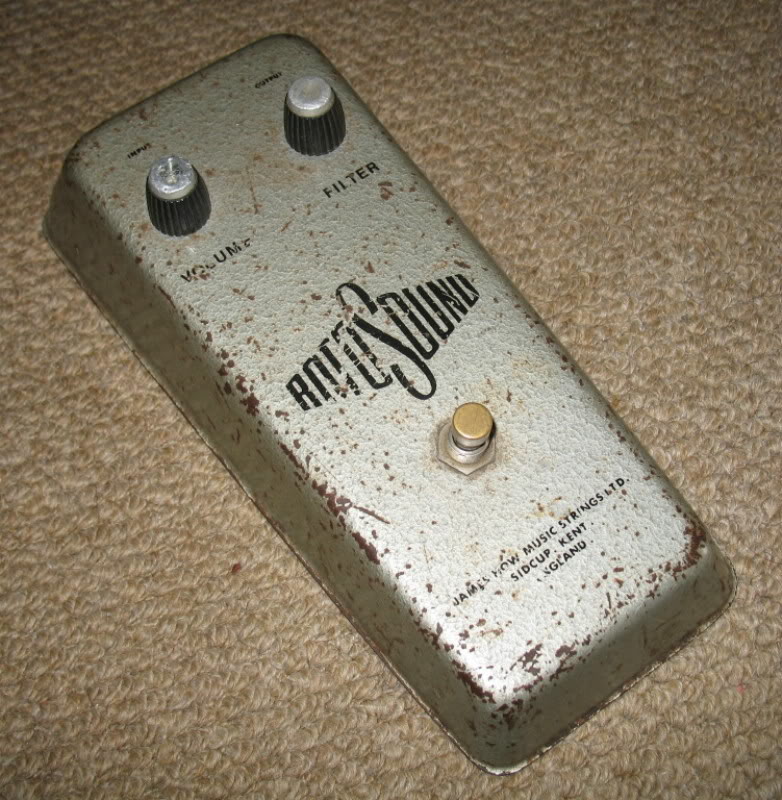
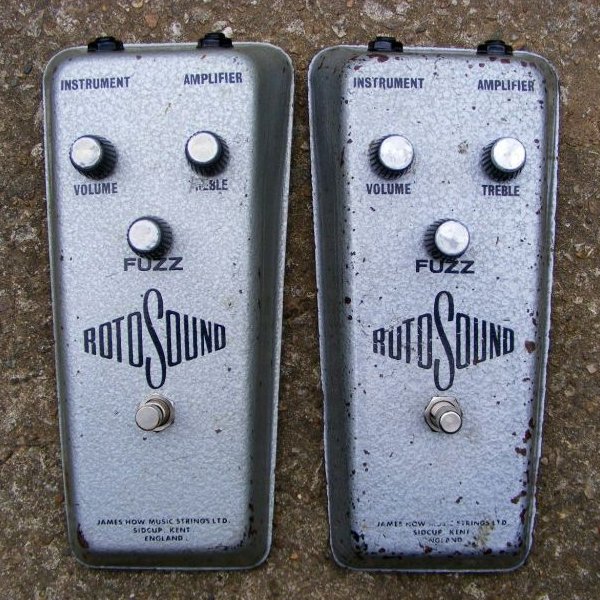
Sola Sound continued supplying Rotosound with fuzz boxes, but 1968 marked a shift in the construction & cosmetics of these pedals. Sola Sound had discontinued using cast aluminium casings for their growing range of fuzz pedals, and replacing these, was a more rounded enclosure, made out of pressed steel. (Photo credit: S. Castledine & D. Main)
As with previous versions of Sola Sound’s Rotosound Fuzz Box, these pedals in the pressed steel housings were built with a variety of different circuits over a number of years. Earlier versions of the pressed steel model can be identified by the fact that they came with only two control knobs. These pedals are particularly scarce, but have been sighted with various late production examples of the Tone Bender MKII circuit.
By 1969, the Rotosound Fuzz Boxes in the pressed steel housings featured the more conventionally seen three-knob setup. These three-knob Fuzz Boxes used the same Tone Bender MKIII circuit, which was ultimately Sola Sound’s fuzz circuit that replaced the MKII. These ‘MKIII’ Rotosound Fuzz Boxes were built with the same electronic circuits that Sola Sound was also supplying to companies like Vox & Park concurrently.
According to date codes in surviving pedals, it can be ascertained that Sola Sound continued manufacturing the Fuzz Box for Rotosound at least until the early 1970s.
Rotosound Fuzz (manufactured by Jennings), c. 1968-1969
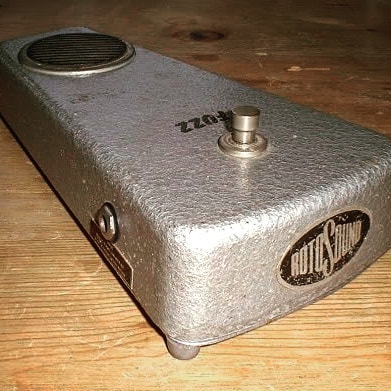

For a brief period, starting in November 1968, the Rotosound formed a partnership with the newly founded Jennings company2 and this resulted in some of the Jennings pedals being rebranded for Rotosound. This was probably a short-lived arrangement, and relatively few Rotosound-branded Jennings pedals were built, because there is only one exemplar that is known to have actually survived. The Rotosound Fuzz pictured above is identical to the more familiar Jennings Fuzz, apart from bearing a different brand name. (Photo credit: S. Castledine)
Other Rotosound-branded pedals were reported to have been built by Jennings at the time, including the wah-wah and the ‘Growler‘ (fuzz & wah) models. No examples of either are yet known to have survived.
Mystery ‘Rotosound’ pedal, unknown date
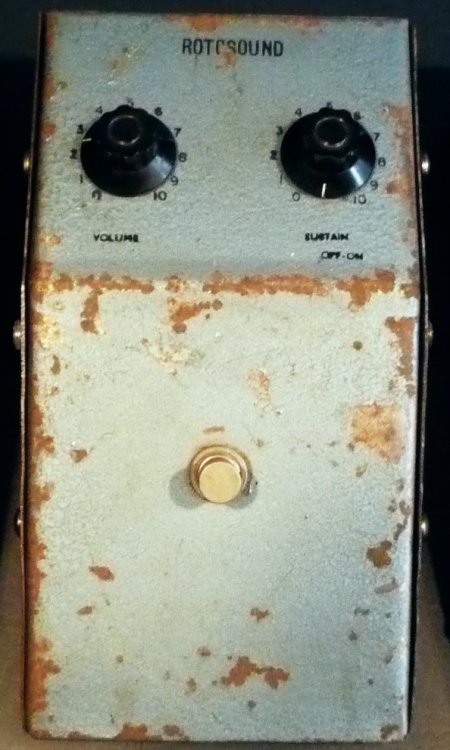
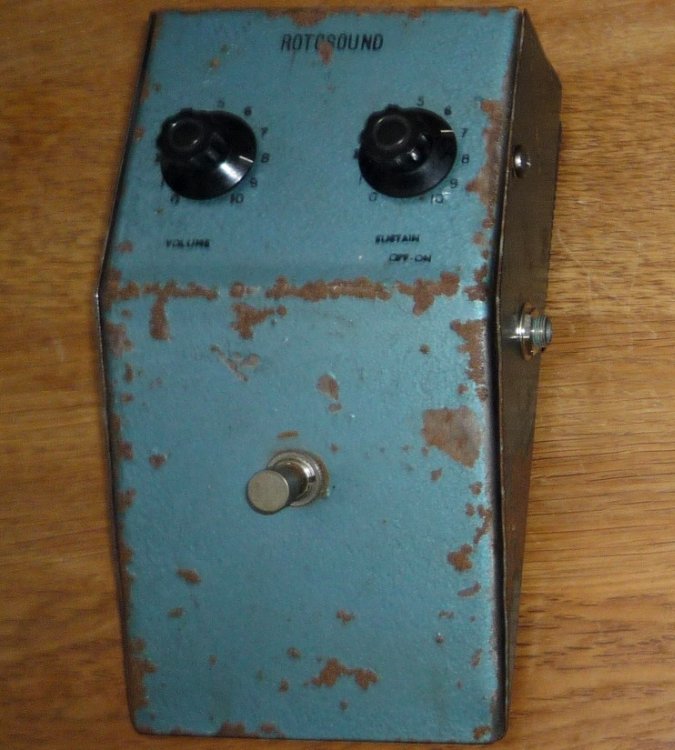
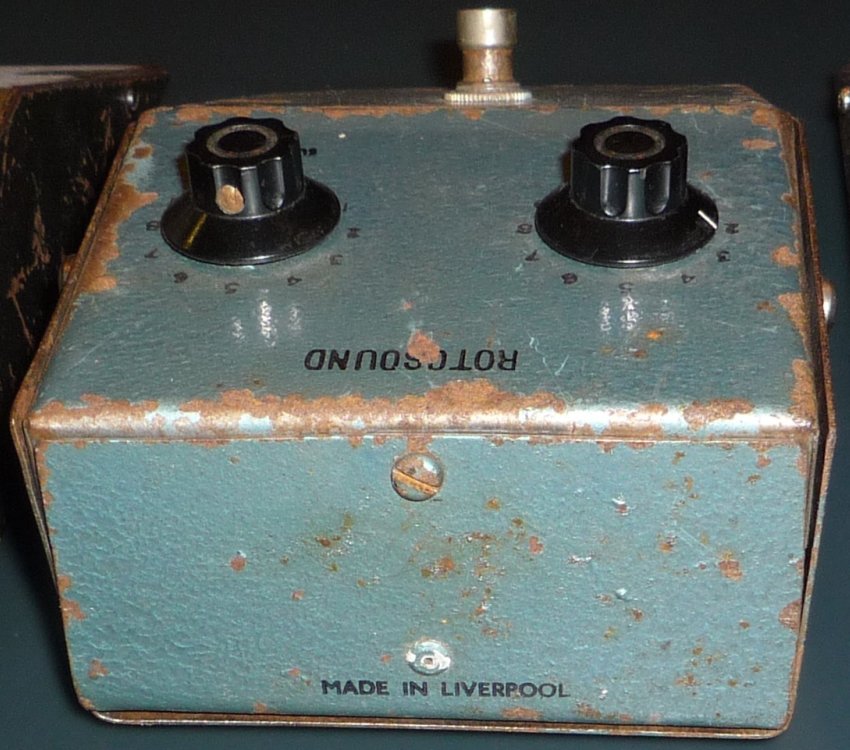
Pictured above is another Rotosound-branded fuzz box. The unit is housed in an enclosure that looks very similar in construction & dimensions to the John Hornby Skewes Zonk Machine but it is unknown at this time whether the two models are related at all. (Photo credit: G. Green)
Corrosion on the enclosure suggests that this Rotosound pedal was built from bent steel, which is unlike the Zonk Machines that were made from aluminium. Text on the battery cover reveals that the mysterious Rotosound pedal was built in Liverpool.
Share your fuzz!
I welcome any comments, feedback, queries & corrections in relation to the Fuzzboxes.org project. Please get in touch via this contact form (or on the ‘contact‘ page).
Much of our understanding of the development of 1960s fuzz boxes comes from analysis of surviving pedals themselves, and so photos of pedals belonging to readers are particularly useful in furthering this research.
If you would like to contribute pictures of 1960s-era guitar effects to Fuzzboxes.org, then feel free to send in any pictures via the uploader below. Photos are greatly appreciated, and any submissions are not published on this website without advance agreement with the contributor.
- https://www.rotosound.com/our-story
- Beat Instrumental, January 1969, p. 29


I purchased an unbranded Fuzz Box in 1966 from Frank Hessey Music in Liverpool. It was the blue hammerite cat box with two controls and the word Fuzzbox on the top.
I never knew the manufacturer as there was nothing on the pedal or inside where the 9v battery lived. As soon as I saw the picture on your site I knew it. I sold the box a couple of years later to move to different (not necessarily better) equipment. I wish now that I had kept it.